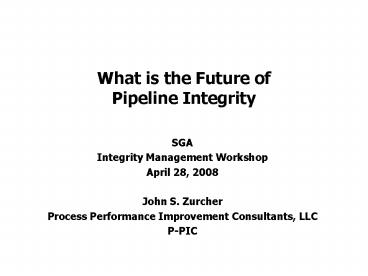What is the Future of Pipeline Integrity - PowerPoint PPT Presentation
1 / 19
Title:
What is the Future of Pipeline Integrity
Description:
Number of Repairs Made in Non-HCA Miles of Pipe. 810. 457 ... One common issue is level of detail in the plan, Framework versus a fully developed IM Program ... – PowerPoint PPT presentation
Number of Views:33
Avg rating:3.0/5.0
Title: What is the Future of Pipeline Integrity
1
What is the Future of Pipeline Integrity
- SGA
- Integrity Management Workshop
- April 28, 2008
- John S. Zurcher
- Process Performance Improvement Consultants, LLC
- P-PIC
2
2002 to 2006 Onshore Incidentswhich Resulted in
a Ruptures and Leaks
3
(No Transcript)
4
(No Transcript)
5
(No Transcript)
6
(No Transcript)
7
(No Transcript)
8
(No Transcript)
9
Most Frequent IMP Violations
- 192.911 Elements of Program 73
- 192.917 Threat Identification 60
- 192.935 Prevention and Mitigation 32
- 192.933 Actions to Address Integrity 31
- 192.925 ECDA 28
- 192.905 HCA Identification 17
- 192.937 Continuous Improvement 17
- Based on approximately 350 NOA and NOPV Items
10
192.911 Violations
- This paragraph is more general in its
requirements. It seems that if the inspector was
not sure what paragraph to cite, this paragraph
was used. - Common issues included
- Did not identify HCAs
- Did not have BAP or perform Risk Assessment
Correctly - Inadequate procedures or records
- Inadequate MOC and handling of changes to plan
- Inadequate QA and QC in the plan processes
- Did not follow the requirements of ASME
- One common issue is level of detail in the plan,
Framework versus a fully developed IM Program
11
192.917 Violations
- Integrating data was not sufficient
- Did not consider near neutral SCC
- Technical justification for not considering
threats - Data gathering a quality not addressed
- PM measures not driven by data
- Seam integrity not considered
- Did not employ look-back based on results
12
192.935 Violations
- Prevention and mitigation measures not identified
- PM measures not evaluated for effectiveness
- No decision process for when to employ PM
measures - No process for how to select PM measures
- No documentation of PM measures
- PM measures did not include evaluation or
determination for use of ACV or RCV
13
192.933 Violations
- Did not provide for pressure reduction prior to
and during examination - Did not define Discovery of Condition time
frame - Did not have a work plan or schedule for
remediation - Immediate conditions not defined (SCC, etc.)
- Did not record dates of examination and repair
- Did not have plan for dealing with Monitored
Conditions and future Risk Assessments
14
192.925 Violations
- Documentation of all steps not complete
- Did not follow the NACE standard
- Did not examine pipe within reasonable time frame
- Did not include encroachment data in process
steps - Feasibility step not always done or not done
first - Documentation of tool selection
- Did not have more restrictive requirements for
first time DA process use.
15
192.905 Violations
- Public sources of information on identified sites
not used - Public officials not contacted
- No process to identify HCAs during routine OM
activities such as patrolling - HCA process was not adequate
- New HCAs not incorporated into BAP within one
year
16
192.937 Violations
- Reassessment intervals not determined
- Did not include near neutral SCC into plans
- Did not have provision for annual review of BAP
- Did not have process to select future assessment
tools - Periodic evaluations not based on risk assessment
- Inadequate documentation for periodic evaluation
- No provision to incorporate new information into
risk assessment
17
What are we not doing well ?
- Assessment results not consistent with what is
found - Vendor performance seems to vary significantly
- Tool performance seems to vary significantly
- Over digging the indications from assessments
- Spending too much money chasing indications that
do not require mitigation - Being very conservative in the performance of the
program - Still treating IMP as a pig-and-dig program
- Managing internal corrosion through gas quality
criteria and enforcement
18
What are doing badly ?
- Performing prevention and mitigation activities
for the long term as part of the life-cycle of
integrity management, taking credit for PM
activities - Keeping up with the year-to-year maintenance and
capital replacement of facilities - Looking at the three sides of integrity
management - ILI for determination of pipe condition
- Pressure test for determination of pipe strength
- Direct assessment to determine environment around
the pipe - Getting standards and regulations changed to
reflect what we have learned over the past five
years - Changing the IMP program and plans to reflect
what we have learned
19
What is the Future of Pipeline Integrity ?
- Using IMP for Class Change Special Permits
- Using IMP for MAOP Special Permits
- Increasing the 7-year interval through Special
Permits - Guided Wave Technology Waivers
- Near-neutral SCC DA
- Dent with Metal Loss Criteria
- Cost Benefit information
- After the Baseline Assessments are more miles
brought into the program? - More tools and combined tools
- Determine the value of Risk Assessment after BAP































